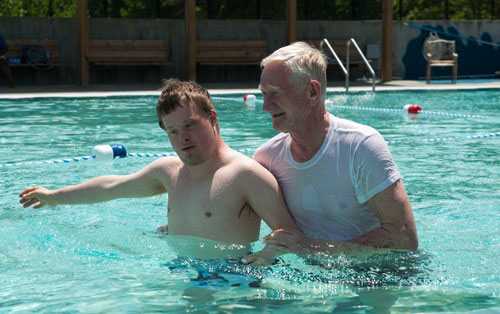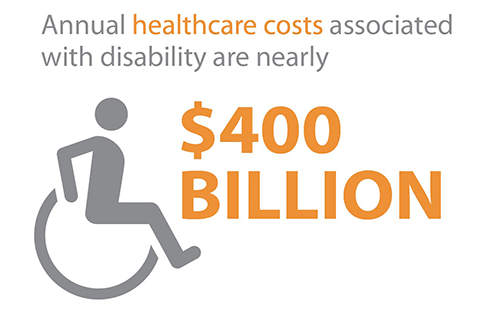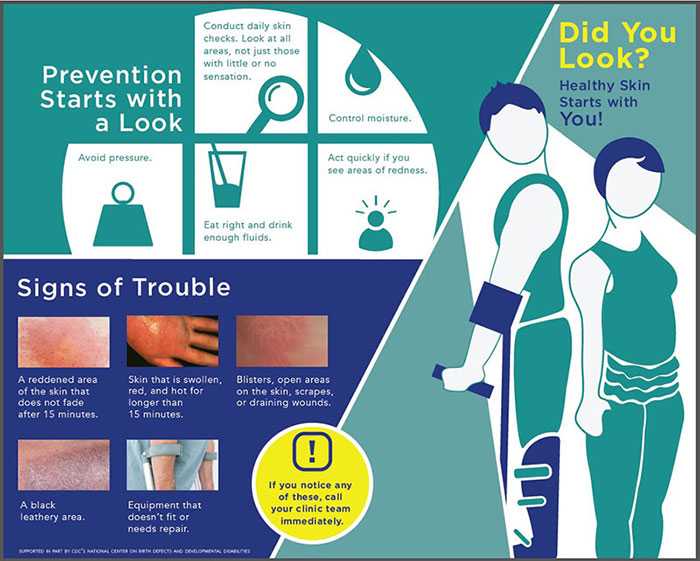Improving the Health of People with Disabilities
 CDC’s National Center on Birth Defects and Developmental Disabilities (NCBDDD) ensures that people with disabilities have the same opportunity for good health as people without disabilities.
CDC’s National Center on Birth Defects and Developmental Disabilities (NCBDDD) ensures that people with disabilities have the same opportunity for good health as people without disabilities.

Disabilities may include difficulty with movement; hearing; seeing; or concentrating, remembering, or making decisions. One of every five adults in the United States has some type of disability, and many people will experience a disability during their lifetimes.
Compared to adults without disabilities, adults with disabilities are more likely to be obese, smoke, have high blood pressure, and be physically inactive. These are all preventable factors that can increase the risk for chronic diseases, such as heart disease, stroke, diabetes, and some cancers, which are also more common among adults with disabilities.
Budget
Accomplishments
- Launched the Physical Developmental Delays: What to look for tool designed for parents who are concerned about the physical development of their child, but do not have a diagnosis. It was developed as part of a 3-year collaboration between NCBDDD and the American Academy of Pediatrics (AAP) in response to research generated from NCBDDD’s Muscular Dystrophy Surveillance, Tracking, and Research Network (MD STARnet). The tool is an interactive checklist which gives parents the language and support they need to talk to their child’s doctor about developmental concerns.
- Created Fragile X Myth Buster handouts for families and pediatricians to address misperceptions that can contribute to a delayed or missed diagnosis of fragile X syndrome (FXS). This project was developed as part of a collaboration with AAP to help pediatricians decrease the time between suspecting a developmental delay to getting the correct genetic test and diagnosis of FXS.
- Nineteen State Disability and Health Programs and two National Centers on Disabilities were awarded cooperative agreements to work to improve the health and quality of life among people with mobility limitations and/or intellectual disabilities through adaptation and implementation of evidence-based strategies in their communities, and at the state level. These 19 state programs ensure that individuals with disabilities are included in ongoing activities that prevent disease and promote health within the state. The National Centers on Disability—Special Olympics and the National Center on Health, Physical Activity and Disability (NCHPAD)—develop, implement, evaluate, and report on activities aimed at reducing health differences between people with and without disabilities and improving the health of people with mobility limitations and/or intellectual disabilities across their lifespans.
- Released Emergency Preparedness: Including People with Disabilities, an online catalog of materials developed by NCBDDD-funded disability and health programs to support emergency preparedness and response activities for people with disabilities. The catalog includes materials for identifying the needs of people with disabilities; communication and training; and assessment of emergency plans, shelters, and policies.
- Collaborated with the National Association of Chronic Disease Directors to fund communities within five of its State Disability and Health Programs (Iowa, Montana, New York, Ohio, and Oregon) to build disability inclusive communities. Provided technical assistance and guidance to NCHPAD, also funded by NCBDDD, for the development of their Inclusive Community Health Implementation Package (iCHIP), which was used to help the initiative. iCHIP is a set of resources and survey tools used to help communities gather and use information regarding healthy living resources for all members of the community, including persons with disabilities.

Looking to the Future
NCBDDD collects data on people with genetic disorders, birth defects, and disabilities across the lifespan in order to promote full participation for those affected. We strive to ensure that people with disabilities can fully participate in society. We will continue our research and public health programs, with an eye towards reducing health disparities and promoting inclusion for people with all types of disabilities, including those with intellectual disabilities. Health education and promotion is crucial to increase awareness. We will use all appropriate means to reach health professionals and other important audiences with information about disability and health.
Notable 2016 Scientific Publications
Kwon JM, et al. Clinical follow-up for Duchenne muscular dystrophy newborn screening: A proposal. Muscle Nerve. 2016 Aug;54(2):186-91.
Learn about NCBDDD’s Disability Topics
Lamb M, et al. Corticosteroid treatment and growth patterns in ambulatory males with Duchenne muscular dystrophy. J Pediatr. 2016 Jun;173:207-13.
Radcliff E, et al. Factors associated with the timeliness of postnatal surgical repair of spina bifida. Childs Nerv Syst. 2016 Aug;32(8):1479-87.
Reichard A, et al. Testing the feasibility of a passive and active case ascertainment system for multiple rare conditions simultaneously: The experience in three US states. JMIR Public Health Surveill. 2016 Aug 29;2(2):e151.
Routh JC, et al. Design and methodological considerations of the National Spina Bifida Patient Registry Urologic and Renal Protocol for the Newborn and Young Child. J Urol. 2016 Dec;196(6):1728-34.
Stevens AC, et al. Adults with one or more functional disabilities — United States, 2011–2014. MMWR Morb Mortal Wkly Rep. 2016;65:1021-25.
Valdez R, et al. Public health and rare diseases: Oxymoron no more. Prev Chronic Dis. 2016 Jan 14;13:e05.
Watson KB, et al. The attributable proportion of specific leisure-time physical activities to total leisure activity volume among US adults, National Health and Nutrition Examination Survey 1999-2006. J Phys Act Health. 2016 Aug;24:1-24.
Spotlight On: Spina Bifida Association
This spotlight was contributed by Sara Struwe, MPA, President and CEO, Spina Bifida Association
Spina bifida (SB) is one of the most complex birth defects and leads to lifelong disability and potential illness. Identifying strategies to improve care and overall health are vital for the Spina Bifida Association (SBA).
CDC awarded a cooperative agreement to SBA to bring together people and organizations that could implement a strategy to improve care and quality of life for people with SB. This ongoing collaboration is called the Spina Bifida Collaborative Care Network (SBCCN). This network takes research from CDC’s National Spina Bifida Patient Registry and delivers those findings to healthcare professionals at SB specialty clinics.
The SBCCN will disseminate and implement a new project addressing pressure sores among people with SB. Almost half of all people with SB get pressure sores, and they are very difficult to treat. The National Spina Bifida Patient Registry data indicate this issue is an important part of SB care.
Practitioners from SB clinics reviewed existing literature on best skin care practices and determined that training and education reduced occurrences of pressure sores in hospitalized patients. These practices could likely be modified and used in an outpatient setting of a SB clinic. CDC and SBA created the Did You Look? skin breakdown prevention program. The program reinforces daily skin checks to prevent pressure sores and emphasizes the importance to quickly report and treat redness or suspicious changes to the skin. Program components include a risk assessment tool, a skin assessment tool, and an education campaign.
The SBA was able to use the partnership with CDC to leverage private dollars to fund the education component of the Did you Look? campaign. This project is the first organized effort to implement a targeted skin care program in SB clinics.
The SBCCN and the Did You Look? campaign are two examples of the partnership between CDC, the SBA, and SB specialty clinics to improve the health of people with SB.

Poster from the, “Did You Look?” Skin Breakdown Prevention Program.
- Page last reviewed: January 24, 2017
- Page last updated: January 24, 2017
- Content source:


 ShareCompartir
ShareCompartir

